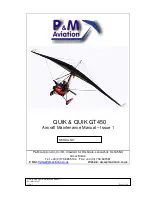
13
Active Flying
The Elan 3 has good pitch stability. Nonetheless, in turbulence or during manoeuvres, the
glider may pitch. If the glider pitches in front of you, apply brake to slow it down. If the
glider drops behind you, ease off the brakes to allow it to speed up. The objective is to
reduce the pendulum effect by adjusting the angle of attack and speed of your glider so
that glider and pilot are travelling at the same speed. When the conditions are turbulent, be
more active and anticipate the movements of the wing. Practice active flying to eliminate
collapses in all conditions. Try to keep tension on the brakes approximately equal to the
weight of your arms. This allows you to stay relaxed and sensitively feel the internal
pressure in the wing through the brakes. If you feel a loss of pressure in one or both sides
of the wing, quickly apply the appropriate brake(s) to regain pressure. Release the brake
promptly as soon as normal pressure is resumed. If you miss the above timing and get a
collapse, be sure to first raise your hands and release the brakes before considering any
other corrective actions.
C-riser control
The Elan 3 responds very nicely to C-riser control. When gliding at trim speed or in
accelerated flight, we recommend to pilot to control the wing with the C risers. This gives
an improved feel and control over the wing enabling you to fly actively without using the
brakes (which causes drag and pitch movements). The objective is to control pitch so that
the wing does not collapse and stays above the pilot. By pulling the C risers down or
rearwards you increase the angle of attack and return the wing to trim speed. With C riser
control you can fly actively through turbulence, collapses can be avoided or at least
reduced with correct inputs. During accelerated flight, the added control of active C riser
flying further increases the efficiency and stability of the wing. Whilst accelerated the act of
pulling
the
C risers is exactly the same as releasing the speed bar. When pushing the bar, if the air
becomes slightly turbulent apply some pressure to the C risers, when the air becomes less
turbulent again you can reduce (or release) pressure on the C risers for extra speed. Flying
fast and efficiently in normal air requires constant attention to the wing, it is necessary to
combine C riser inputs and speed bar adjustments to keep the wing open and pressured.
C-riser control can also be used for steering. Following lifting lines using the C-risers can
make a huge difference to flight performance. To fly with the C risers, keep hold of your
brake toggles (remove any wraps) and either rest your hands on or take hold of the sticks
located on the C risers. The control movement should be subtle and fluid - only small
movements are required. It is good practice to glide with gentle tension applied to the
C-risers (pulling them backwards about 4 to 7 cm) so that you can feel the inputs from the
wing. Those inputs warn you when turbulence is coming, but also allow you to feel the lifty
side of the wing - when the tension on the C-riser on one side increases, pull down on that
side to turn slightly towards the lifting air. This control method is suitable for gliding in good
‘normal’ air without huge levels of turbulence, it does not replace proper active flying with
the brakes in strong turbulent conditions. If you are unsure about the air return the glider to
trim speed, release the C risers and fly the glider actively with the brakes.
Содержание elan3
Страница 1: ...1 ...
Страница 31: ...31 LINE PLAN ELAN 3 ...
Страница 34: ...34 CHECKS Name Company Date Signature Stamp ...
Страница 36: ...36 ...
Страница 37: ...1 ...
Страница 70: ...34 PLAN DE SUSPENTESELAN 3 ...
Страница 74: ...38 CONTROLES Nom Entreprise Date Signature et cachet ...
Страница 76: ...40 ...














































